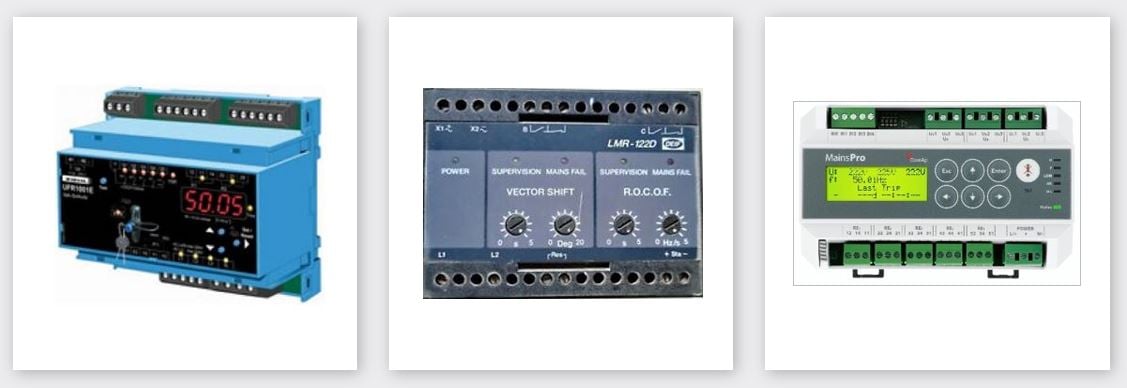A guide to LoM protection
A guide to Loss of Mains protection
On this page you will find guidance information to help you confirm if your generation protection settings are compliant with Engineering Recommendation G59/3-7 or if they need upgrading.
Introduction
An issue has been discovered with some generators which were connected prior to March 2018. Although they were compliant with the required standards at the time, there has been a change to the codes of practice which govern generating units larger than 16A per phase (>3.68KW single phase, 11.04kW three phase). Funding has been made available to make these changes, which need to be made before September 2022.
Identifying if your site is compliant
Depending on the type of Loss of Mains protection that you currently have installed, you may have to update the settings or replace the device installed in order to comply with the new requirements. The two forms of protection which this update seeks to find and modify the settings for are Rate of Change of Frequency (RoCoF) and Vector shift.
The first point to check is whether you have RoCoF or Vector shift on your generator. There are two forms of generation protection which are utilised; these are inverters and programmable protection relays. Some sites may have a combination of both and if this is the case on your site then you need to check that both are compliant.
Inverters
Inverters are predominantly utilised to convert energy generated from solar panels, and batteries; however, they are also sometimes utilised to connect other generation technologies such as wind and hydro power. The majority of inverters are separate from the generation source and are a wall mounted box. Some common examples of inverters are shown below:

If your site has solar panels or batteries and you cannot locate the inverters, they may be embedded within the generation equipment itself e.g. some solar panels have built in inverters. If this is the case then you will need to check the respective information of that make and model of generating unit.
Inverters are generally pre-programmed by the manufacturer and are type-tested before being sold. This means that in the majority of cases the pre-programmed settings are known, and by checking the manufacturers data it is possible to find out if your inverter(s) are compliant with this programme.
Some inverter manufacturers have declared their equipment was either compliant or non-compliant with the programme. A list of these manufacturers and the information they have given is provided here. We would encourage you to speak to the inverter manufacturer in cases where the status of a particular inverter type have not been confirmed. Once you have identified if your site has a compliant inverter(s) then you need to let us know so that we can update our records.
Where an inverter has non-compliant settings, these can often be modified through a software update by a trained installer or the original manufacturer. If the settings do require changing as a result of this update, please ensure you make the necessary changes as soon as possible to avoid enforcement action.
G59 protection relays
Some generators were installed with a G59 protection relay. These relays are generally more prevalent for sites which have rotating generation equipment e.g. wind, gas engines, diesel engines, hydro, biomass, etc. These relays are also very common for sites with a generation capacity greater than 50kW. Sites may have a combination of inverters and relays and both need to be made compliant with this program. A G59 protection relay will have been set by the generation installer and often they will have supplied a test sheet showing the settings they have programmed. Locating this sheet can dramatically help with establishing what settings are installed. If you have a generator which was installed prior to March 2018 and it has a G59 protection relay, it is highly likely that the settings will require adjusting in line with this programme. The images below show some common examples of G59 relays:

For some generators the G59 relay is situated within the generator control unit, which can sometimes be inaccessible other than via specialised access by a trained professional e.g. inside wind turbines. We would advise in this case to get in contact with a trained professional to carry out these checks.
If you know or think you have a G59 relay onsite and you suspect or know it has old loss of mains protection settings (pre-March 2018) then it is best to consult a trained installer who can check this and discuss options for the modification of the settings or the replacement of the relay (if appropriate). If the settings do require changing as a result of this programme, funding has been made available to cover some of the costs; however you will need to apply for funding prior to making any changes.
Additional ways to check if you have inverters or relays
Generally, the generator should have a simple wiring diagram displayed near the point where the electricity supply enters the building or near to the generation unit. This can often give clues as to where and what the protection is. Another good source of information is a G59 test sheet which should also have been part of the installers commissioning paperwork. In the case of relays these test sheets should indicate if RoCoF (sometimes noted as df/dt, measured in Hzs-1) or Vector shift (measured in degrees) are present.